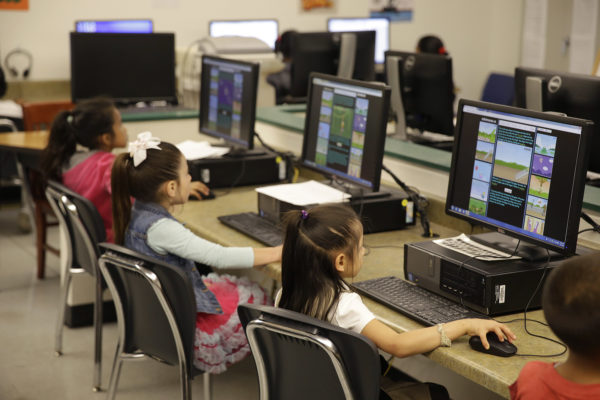I work with roughly 500 kindergarten through 5th-grade students. As part of their curriculum, students receive 40 minutes each week of technology class. During the first quarter, we focus on the keyboard.
Today’s students are expected to have some typing proficiency as early as kindergarten. For example, our students must be able to, at minimum, type their first and last name in order to access their devices and accounts. Our 2nd– through 5th-graders take computer-based assessments which require them to type constructed responses to questions. Learning to type is not an option for our students; it’s an essential skill.
Many of our young learners barely know their letters, let alone are ready to master touch-typing. Most sites that teach typing are timed, or require kids to type line after line of text. The games on these sites often require a mastery of the home row before kids can be successful. These games move so fast that they’re “over” before our little guys can even find the first letter on the keyboard.
Additionally, many of our youngest learners have never used a mouse or trackpad before, so navigating the cursor around the screen is a skill in and of itself.
The Keyboard for Kindergarteners
For my students who don’t yet know their letters and are unfamiliar with the layout of the keyboard, we use a free, game-based platform called TypeTastic.
I start my kindergartners, and even my 1st-graders, with very basic, arcade-style games that allow them to strengthen their mouse skills, and at the same time introduce them to the layout of the keyboard. The games use bugs and frogs and trucks to engage students, and they provide differentiation for various skill levels. These games build students’ letter-recognition skills and help them to understand the concept that the keyboard has its own specific layout.
As the weeks progress, we move into locating letters on the keyboard. With my kindergartners, the focus is less on proper technique and more on locating letters. The games start out very basic, so kids can easily figure out the objective of each game and are able to be successful from the very beginning. This encourages them to persevere as the levels get more challenging.
The games aren’t timed, which gives my little ones the time they need to locate keys and not feel rushed to “pound the keyboard.” They’re given as many tries as they need, without penalty. This is huge in getting my reluctant learners to stick with the task and not become overwhelmed or frustrated.
(Next page: Taking the fun approach to the keyboard)
Taking the Fun Way to the Home Row
My 1st-grade students are beginning to work on identifying and using the home row keys. During our first lesson this year, we gathered on the carpet to review finger placement and watched the tutorial from the Keyboarding Kickstart game. I modeled placing my fingers on the home row using our document camera, then sent students off to their computers and asked them to begin with the Home Row game.
The kids were off and buzzing, getting logged into their devices. Managing the home row is quite a task for those little fingers. They’re still developing the fine motor skills and dexterity to get those fingers matched up on the right keys. I stood back and watched as the room went from furrowed brows, tongues sticking out of the corners of mouths, and utter concentration, to expressions of sheer delight!
I watched them celebrate their success as their determination and perseverance mastered level after level. They started with using one hand at a time, then added the other hand. At this level, we don’t expect students to use proper finger placement to key letters, but having a visual model of the hand helped them “know” where their hands were without having to look. The kids were thrilled with all of the stars they’d earned, and couldn’t wait to move on.
After giving them time to stretch their comfort zone, I allowed them to switch and choose one of the other games from the second module of TypeTastic. Each kid was able to self-evaluate and differentiate. They moved to a game that matched their ability level and also met the objective for that day.
My 2nd-graders begin the year with some of the same games as the 1st-graders, but at this level we expect them to start mastering the home row and using the proper technique. I show the tutorial again to remind students of the technique they should use when typing, again focusing on a single hand to meet our goal of “using the right hand to key letters on the right side of the keyboard” and vice versa.
My older students use a program called EduTyping, but I use TypeTastic as an end-of-class reward. It’s a welcome break from typing line after line of copy. My 2nd– through 5th-graders particularly like puzzle-based games. They tend not to mind the typing aspect because they’re more focused on solving each puzzle.
For all of our primary learners, learning to type is more than a question of manual dexterity; it also helps them learn their alphabet. For the students I work with in particular, it helps with capital and lowercase matching. The devices we use have lowercase-only keyboards, so I definitely appreciate having a way to help students learn to match capital and lowercase partners.
October is Digital Citizenship Month, so we focused on that during the majority of our tech time last month, but we still have our “typing 10” during each class. Students look forward to playing games as they continue to build the typing skills that they’ll all need sooner rather than later.
- 4 ways to encourage play in education - April 25, 2024
- CoSN IT Leader Spotlight: Lisa Higgins - April 25, 2024
- It’s time to pay student teachers - April 25, 2024


